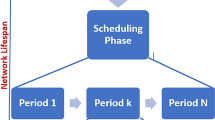Abstract
Wireless sensor network (WSN) is a wireless network composed of a large number of static or mobile sensors in a self-organizing and multi-hop manner. In WSN research, node placement is one of the basic problems. In view of the coverage, energy consumption and the distance of node movement, an improved multi-objective optimization algorithm based on NSGA2 is proposed in this paper. The proposed algorithm is used to optimize the node placement of WSN. The proposed algorithm can optimize both the node coverage and lifetime of WSN while also considering the moving distance of nodes, so as to optimize the node placement of WSN. The experiments show that the improved NSGA2 has improvements in both searching performance and convergence speed when solving the node placement problem.









Similar content being viewed by others
References
Baghaee, S., Zubeyde Gurbuz, S., & Uysalbiyikoglu, E. (2015). Implementation of an enhanced target localization and identification algorithm on a magnetic WSN. IEICE Transactions on Communications, E98.B(10), 2022–2032.
Alemdar, H., & Ersoy, C. (2010). Wireless sensor networks for healthcare: A survey. Computer Networks, 54(15), 2688–2710.
Wang, L., An, L., Ni, H.-Q., Wei, Y., Pardalos, P. M., & Fei, M.-R. (2016). Pareto-based multi-objective node placement of industrial wireless sensor networks using binary differential evolution. Advances in Manufacturing, 4(1), 66–78.
Jin, N., Ma, R., & Lv Y, et al. (2010). A novel design of water environment monitoring system based on WSN. In International Conference on Computer Design and Applications. IEEE (pp. V2-593–V2-597).
Akyildiz, I. F., Su, W., Sankarasubramaniam, Y., et al. (2002). A survey on sensor networks. IEEE Communications Magazine, 40(8), 102–114.
Tsai, C. W., Hong, T. P., & Shiu, G. N. (2016). Metaheuristics for the lifetime of WSN: A review. IEEE Sensors Journal, 16(9), 2812–2831.
Abidin, H. Z., Din, N. M., & Radzi, N. A. M. (2014). WSN sensor node placement approach based on multi-objective optimization. In Region 10 Symposium. IEEE (pp. 111–115).
Guangjie, F. U., Mingzhe, H. U., & Yongna, Q. (2017). WSN node distribution optimization based on improved bee colony algorithm. Journal of Jilin University, 35(5), 507–512.
Gupta, G. P., & Jha, S. (2019). Biogeography-based optimization scheme for solving the coverage and connected node placement problem for wireless sensor networks. Wireless Networks, 25, 3167–3177.
Abidin, H. Z., Din, N., Yassin, I., et al. (2014). Sensor node placement in wireless sensor network using multi-objective territorial predator scent marking algorithm. Arabian Journal for Science & Engineering, 39(8), 6317–6325.
Oldewurtel, F., & Mahonen, P. (2010). Analysis of enhanced deployment models for sensor networks. In Vehicular Technology Conference. IEEE (pp. 1–5).
Chen, Y., & Zhao, Q. (2005). On the lifetime of wireless sensor networks. Communications Letters IEEE, 9(11), 976–978.
Chen, Y. R., Ren, T. J., Wang, Z. Q., et al. (2011). Lifetime maximization routing based on genetic algorithm for wireless sensor networks. Advanced Materials Research, 230–232, 283–287.
Deb, K., Pratap, A., Agarwal, S., et al. (2002). A fast and elitist multiobjective genetic algorithm: NSGA-II. IEEE Transactions on Evolutionary Computation, 6(2), 182–197.
Haneef, M., & Deng, Z. (2012). Design challenges and comparative analysis of cluster based routing protocols used in wireless sensor networks for improving network life time. Advances in Information Sciences and Service Sciences, 4(1), 450–459.
Heinzelman, W., Chandrakasan, A., & Balakrishnan, H. (2000) . Energy-efficient protocol for wireless microsensor networks. In Hawaii International Conference on System Sciences (pp. 3005–3014).
Author information
Authors and Affiliations
Corresponding author
Additional information
Publisher's Note
Springer Nature remains neutral with regard to jurisdictional claims in published maps and institutional affiliations.
Rights and permissions
About this article
Cite this article
Zhang, Y., Liu, M. Adaptive directed evolved NSGA2 based node placement optimization for wireless sensor networks. Wireless Netw 26, 3539–3552 (2020). https://doi.org/10.1007/s11276-020-02279-2
Published:
Issue Date:
DOI: https://doi.org/10.1007/s11276-020-02279-2




